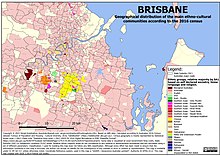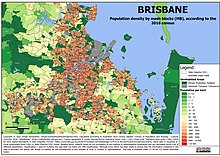Demographics of Brisbane
Brisbane is the capital of and most populous city in the Australian state of Queensland,[1] and the third most populous city in Australia. The Australian Bureau of Statistics estimates that the population of Greater Brisbane is 2,462,637 as of June 2018,[2] and the South East Queensland region, centred on Brisbane, encompasses a population of more than 3.6 million.[2] The Brisbane central business district stands on the original European settlement and is situated inside a bend of the Brisbane River, about 15 kilometres (9 miles) from its mouth at Moreton Bay.[3] The metropolitan area extends in all directions along the floodplain of the Brisbane River Valley between Moreton Bay and the Great Dividing Range, sprawling across several of Australia's most populous local government areas (LGAs), most centrally the City of Brisbane, which is by far the most populous LGA in the nation. The demonym of Brisbane is Brisbanite.

Country of birth[edit]

| Birthplace[N 1] | Population |
|---|---|
| Australia | 1,726,655 |
| New Zealand | 111,649 |
| England | 95,284 |
| India | 51,650 |
| Mainland China | 41,978 |
| Philippines | 27,907 |
| South Africa | 26,918 |
| Vietnam | 20,308 |
| South Korea | 13,305 |
| Taiwan | 12,826 |
| Scotland | 11,956 |
| Malaysia | 11,826 |
| Fiji | 10,800 |
| United States | 10,530 |
| Hong Kong SAR | 9,799 |
The 2021 census showed that 31.7% of Brisbane's inhabitants were born overseas and 52.2% of inhabitants had at least one parent born overseas.[5] Brisbane has the 26th largest immigrant population among world metropolitan areas. Of inhabitants born outside of Australia, the five most prevalent countries of birth were New Zealand, England, India, Mainland China and the Philippines.[4] Brisbane has the largest New Zealand and Taiwanese-born populations of any city in Australia.[6]
Languages[edit]

At the 2021 census, 77.3% of inhabitants spoke only English at home,[5] with the next most common languages being Mandarin (2.5%), Vietnamese (1.1%), Punjabi (0.9%), Cantonese (0.9%) and Spanish (0.8%).[5]
Ancestry[edit]
At the 2021 census, the most commonly nominated ancestries were:[4]
- English (36.5%)
- Australian (31.6%)[N 2]
- Irish (11.1%)
- Scottish (10.1%)
- German (5.7%)
- Chinese (4.7%)
- Aboriginal (2.8%)[N 3]
- Italian (2.7%)
- Indian (2.7%)
- Dutch (1.6%)
- Filipino (1.6%)
- Maori (1.5%)
- New Zealander (1.4%)
- Samoan (1.2%)
- Vietnamese (1.1%)
At the 2021 census, 3.0% of Brisbane's population identified as being Indigenous — Aboriginal Australians and Torres Strait Islanders.[N 4][5]
Religion[edit]


At the 2021 census, the most commonly cited religious affiliation was 'No religion' (41.4%).[4]
Brisbane's most popular religion at the 2021 census was Christianity at 44.3%, the most popular denominations of which were Catholicism (18.6%) and Anglicanism (9.7%). Brisbane's CBD is home to two cathedrals – St John's (Anglican) and St Stephen's (Catholic).
The most popular non-Christian religions at the 2021 census were Hindu (2%), Buddhist (1.9%) and Muslim (1.8%).[8] Brisbane's religious landscape also includes small but significant communities of Judaism (1.0%) and Sikhism (0.9%).[9]
Historical Populations[edit]

| Year | Pop. | ±% p.a. | ||
|---|---|---|---|---|
| 1826 | 160 | — | ||
| 1831 | 1,241 | +50.64% | ||
| 1841 | 120 | −20.83% | ||
| 1851 | 2,500 | +35.48% | ||
| 1861 | 6,051 | +9.24% | ||
| 1871 | 19,413 | +12.36% | ||
| 1881 | 37,127 | +6.70% | ||
| 1891 | 88,083 | +9.02% | ||
| 1901 | 120,650 | +3.20% | ||
| 1911 | 143,510 | +1.75% | ||
| 1921 | 217,710 | +4.26% | ||
| 1931 | 283,440 | +2.67% | ||
| 1941 | 344,230 | +1.96% | ||
| 1951 | 453,660 | +2.80% | ||
| 1961 | 692,924 | +4.33% | ||
| 1971 | 957,900 | +3.29% | ||
| 1981 | 1,154,705 | +1.89% | ||
| 1991 | 1,411,773 | +2.03% | ||
| 2001 | 1,693,556 | +1.84% | ||
| 2011 | 2,147,436 | +2.40% | ||
| 2016 | 2,270,800 | +1.12% | ||
| 2021 | 2,526,238 | +2.15% | ||
| ||||
| Source:[10][11] | ||||
-
Geographical distribution of Brisbane's population of Chinese origin.
-
Geographical distribution of Brisbane's population of Vietnamese origin.
-
Geographical distribution of Brisbane's population of Korean origin.
-
Geographical distribution of Brisbane's population of Polynesian origin.
-
Geographical distribution of Brisbane's population of Southern Asian origin.
-
Geographical distribution of Brisbane's population of Filipino origin.
-
Geographical distribution of Brisbane's population of German origin.
-
Geographical distribution of Brisbane's population of Italian origin.
-
Geographical distribution of Brisbane's non-Indigenous population of English, Australian, Irish and Scottish origin.
-
Geographical distribution of Brisbane's Indigenous Australian population.
Notes[edit]
- ^ In accordance with the Australian Bureau of Statistics source, England, Scotland, Mainland China and the Special Administrative Regions of Hong Kong and Macau are listed separately
- ^ The Australian Bureau of Statistics has stated that most who nominate "Australian" as their ancestry are part of the Anglo-Celtic group.[7]
- ^ Those who nominated their ancestry as "Australian Aboriginal". Does not include Torres Strait Islanders. This relates to nomination of ancestry and is distinct from persons who identify as Indigenous (Aboriginal or Torres Strait Islander) which is a separate question.
- ^ Indigenous identification is separate to the ancestry question on the Australian Census and persons identifying as Aboriginal or Torres Strait Islander may identify any ancestry.
- ^ Sources: Queensland Treasury (1826-1891), Australian Bureau of Statistics (1901 onwards). Capital cities based on Greater Capital City Statistical Areas (GCCSAs) for 1971 onwards. Populations for previous years are based on earlier boundaries and may be inconsistent with GCCSAs. Pre-1971 may not include the Indigenous population.
References[edit]
- ^ "Brisbane (entry 4555)". Queensland Place Names. Queensland Government. Retrieved 14 March 2014.
- ^ a b "Main Features - Main Features". 25 March 2020. Archived from the original on 25 October 2019. Retrieved 12 May 2019.
- ^ "Brisbane and Greater Brisbane". Queensland Places. Archived from the original on 27 January 2014. Retrieved 23 April 2015.
- ^ a b c d "2021 Greater Brisbane, Census Community Profiles | Australian Bureau of Statistics". Abs.gov.au. Retrieved 1 July 2022.
- ^ a b c d "2021 Greater Brisbane, Census All persons QuickStats | Australian Bureau of Statistics". Abs.gov.au. Retrieved 1 July 2022.
- ^ "2016 Census Community Profile – Greater Brisbane (3GBRI – GCCSA)". Australian Bureau of Statistics. Archived from the original on 14 July 2017. Retrieved 1 July 2017.; [1] Archived 14 July 2017 at the Wayback Machine, ZIPed Excel spreadsheet. Table G09e & G09f
- ^ "Feature Article – Ethnic and Cultural Diversity in Australia". Australian Bureau of Statistics. January 1995. Archived from the original on 20 April 2016. Retrieved 15 June 2019.
- ^ "Archived copy". Archived from the original on 14 July 2017. Retrieved 1 July 2017.
{{cite web}}: CS1 maint: archived copy as title (link) - ^ "People & Lifestyle Brisbane City Qld 4000". www.microburbs.com.au. Retrieved 2 August 2023.
- ^ "3105.0.65.001 - Australian Historical Population Statistics, 2016". Australian Bureau of Statistics. 18 April 2019. Archived from the original on 25 May 2022. Retrieved 23 June 2019. Table 3.1, Capital City(b), 1901 onwards
- ^ "Historical tables, demography, 1823 to 2008 (Q150 release)". Queensland Treasury. 2009. Archived from the original on 1 April 2019. Retrieved 23 June 2019. Table D1, Population by capital city and rest of state, Queensland, 1823 to 2007










